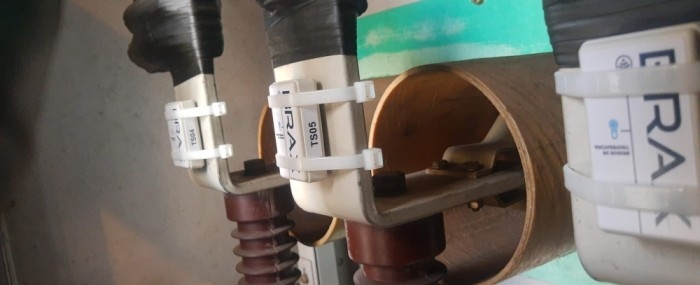


Technology developed by a startup with FAPESP’s support dispenses with manual inspection, diagnosing problems rapidly and accurately, facilitating preventive maintenance, and cutting costs (sensors installed on medium-voltage panel / photo: Brax)
Published on 09/13/2021
By Fábio de Castro | FAPESP Innovative R&D – There is no room for failure in industrial electrical systems. Problems like conductor overheating or a discharge due to defective insulation of a component can lead to unexpected disconnection or fire, with major negative consequences.
The monitoring procedures deployed to avoid these problems are time-consuming, costly, and not always effective. A solution developed by Brax, a startup based in Rio Claro (state of São Paulo, Brazil), is an innovative active monitoring system that replaces manual inspection. Electrical installations are diagnosed rapidly and accurately, preventive maintenance is easily scheduled, and operating costs are cut.
Brax was founded in 2014 and received funding from FAPESP’s Innovative Research in Small Business Program (PIPE) to develop the technology, which can be used to monitor electrical panels, substations, circuit breakers, switches, busbars, cables, insulators, and transformers in industrial facilities.
According to engineer André Luiz Casimiro, who founded Brax, conventional monitoring of this type of installation requires regular on-site manual inspection. “To monitor temperature, for example, an inspector has to visit the site and use a thermographic camera to produce images of specific parts of the system. This can detect any overheating. Ultrasound devices may also be used to detect sounds produced by partial discharges,” Casimiro says.
An arc discharge, or electric arc, occurs when insulation weakens. Like overheating, it can lead to unexpected disconnection or fire. “In a substation, for example, the equipment is constantly exposed to wind and weather. Insulation degrades as time passes, leading to partial discharges inside transformers, panels and breakers,” he notes.
Inspectors cannot come near high-voltage electrical equipment to examine outdoor installations. Substations, for example, have to be shut down and dismantled from time to time as a precaution, and this is risky as well as costly.
“Large-scale industrial electrical installations are too important to fail. Our solution optimizes the laborious prevention process, replacing regular inspections with real-time remote monitoring,” Casimiro explains.
Brax designed its solution for industrial applications and also for use by power distribution utilities. “The higher the installation’s power rating, the more applicable our system, so it’s well-suited to monitoring of substations,” he says.
The project supported by PIPE-FAPESP enabled Brax to develop two sensors, one to monitor equipment temperature by contact and another to detect partial discharges. “The sensors are wireless and coupled to busbars at points we consider essential for monitoring purposes. They don’t have batteries, so there’s no need to switch the system off if they have to be replaced. The data collected is sent directly to the gateway we’ve developed, and can be viewed in real time alongside a detailed operating history,” Casimiro says.
The method guarantees heightened diagnostic precision and reduces operating costs by doing away with inspectors and supplementary equipment. “Our platform prevents accidents because the sensors predict potential problems very reliably. In addition, the process is timely. When an inspector goes to a site, overheating may have been under way for months. Our solution issues a warning to the customer three to four hours after overheating begins or a discharge occurs,” Casimiro says.
In Phase 1 of the PIPE-FAPESP project, approved in 2016, the firm developed its ultrasonic electric arc sensor. In Phase 2, which began in 2018, it focused on temperature monitoring via direct contact with busbars.
“Partial discharges emit energy in the form of light, heat and sound. The sensor captures ultrasound waves, processes the signal, and identifies the discharge. It also monitors ambient temperature and humidity,” Casimiro says.
The firm’s solution includes software that continuously monitors the flow of data from the electrical installation and automatically issues alerts. For example, an email message is sent to management immediately if an incident occurs at an industrial facility.
“A dashboard lets the customer view graphs of temperature and discharge trends, facilitating systematic monitoring either by the customer or by Brax, whichever is more convenient,” Casimiro says.
Risk reduction
The firm is currently transitioning between the pilot project and commercialization. “We’re in the initial stage but already have some customers. Previously, it was necessary to present proof of concept before prospects became customers, but we’re now implementing a sustainable business model,” Casimiro says.
The model entails charging a fee to install the hardware on site and provide the monitoring service. The impact of the solution can be crucial to avoid the substantial disruption caused by unexpected disconnections and fires due to overheating or electric arc.
A fire at a substation in Amapá at the end of 2020, which left this state in the North region of Brazil completely without power for 20 days, is an example of the dramatic impact this type of accident can have. “At the time, the fire was blamed on a lightning strike, but it quickly became known that proper maintenance of the substation wasn’t performed. The fire was probably caused by overheating,” Casimiro says.
Accidents can have a global impact. Also at end-2020, overheating at IBM’s data centers prevented millions of users in Brazil from accessing websites, services and games. Banks such as Caixa Econômica Federal (CEF), Itaú and Nubank, as well as ECT (the post office) and WhatsApp, were also cut off, among others.
“Another case in point was Facebook, where overheating of a server busbar brought the network down for several hours,” Casimiro recalls. “In the US, an airport went dark for six hours because of a problem in its electrical installations. This type of problem doesn’t occur frequently but can have very serious consequences, interrupting services, causing material losses, and endangering workers exposed to the installations concerned.”
Source: https://agencia.fapesp.br/36814